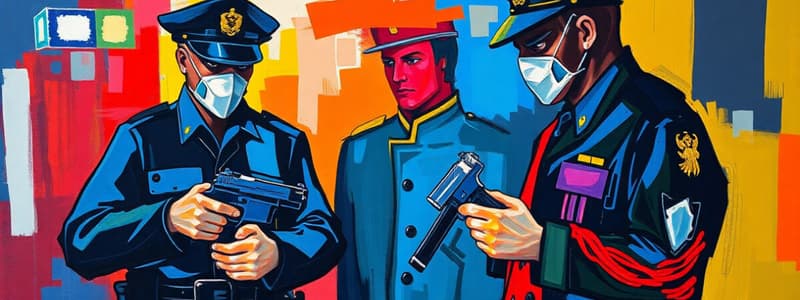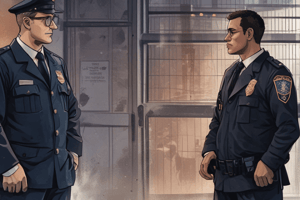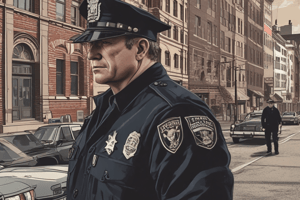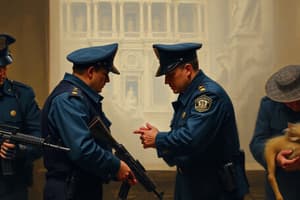Podcast
Questions and Answers
What is the main purpose of the Case Investigation Plan (CIPLAN)?
What is the main purpose of the Case Investigation Plan (CIPLAN)?
- To promote police officers' attendance in court
- To develop training programs for investigators
- To manage operations for sensational and heinous crimes (correct)
- To cover regular crimes and incidents
During court proceedings, what responsibility do COPs/Heads of Units have?
During court proceedings, what responsibility do COPs/Heads of Units have?
- To write the case investigation report
- To represent the accused in court
- To gather evidence for the case
- To ensure the attendance of witnesses (correct)
What should investigators wear to identify themselves as PNP personnel?
What should investigators wear to identify themselves as PNP personnel?
- Civilian clothing
- Prescribed uniforms (correct)
- Formal attire
- Protective gear
Which of the following is NOT considered a tool for gathering facts by an investigator?
Which of the following is NOT considered a tool for gathering facts by an investigator?
What is a key objective during Phase I of an investigation?
What is a key objective during Phase I of an investigation?
What method of gathering facts involves speaking with witnesses and suspects?
What method of gathering facts involves speaking with witnesses and suspects?
What type of evidence is collected in Phase III of an investigation?
What type of evidence is collected in Phase III of an investigation?
Which of the following sources is NOT a suggested information source for investigators?
Which of the following sources is NOT a suggested information source for investigators?
What should be included in the Official Police Blotter regarding a criminal incident?
What should be included in the Official Police Blotter regarding a criminal incident?
Which of the following roles is NOT part of an investigation team?
Which of the following roles is NOT part of an investigation team?
What is a requirement for investigators to be assigned to any police unit?
What is a requirement for investigators to be assigned to any police unit?
Which item is essential equipment for an investigator?
Which item is essential equipment for an investigator?
What status should be recorded in the Police Blotter alongside the incident details?
What status should be recorded in the Police Blotter alongside the incident details?
What is the main purpose of the Police Blotter in criminal investigation?
What is the main purpose of the Police Blotter in criminal investigation?
Which item is NOT considered equipment for an investigator?
Which item is NOT considered equipment for an investigator?
What fact should be documented regarding the circumstances of a crime?
What fact should be documented regarding the circumstances of a crime?
What is one primary purpose of conducting an interview in a criminal investigation?
What is one primary purpose of conducting an interview in a criminal investigation?
In which stage of interrogation is planning considered crucial?
In which stage of interrogation is planning considered crucial?
Which of the following is NOT mentioned as a use of interviews and interrogations?
Which of the following is NOT mentioned as a use of interviews and interrogations?
What type of interrogation is generally conducted without prior planning?
What type of interrogation is generally conducted without prior planning?
What is one objective of a planned interrogation?
What is one objective of a planned interrogation?
What does an unplanned interrogation often involve concerning the person being interrogated?
What does an unplanned interrogation often involve concerning the person being interrogated?
Which of the following aspects is emphasized for the interrogator during a planned interrogation?
Which of the following aspects is emphasized for the interrogator during a planned interrogation?
What is suggested as a potential outcome of gathering information in interviews and interrogations?
What is suggested as a potential outcome of gathering information in interviews and interrogations?
What is the main responsibility of the police station with territorial jurisdiction over a crime scene?
What is the main responsibility of the police station with territorial jurisdiction over a crime scene?
What is contained in the official Police Blotter?
What is contained in the official Police Blotter?
Why must confidentiality be maintained in specific cases in the Police Blotter?
Why must confidentiality be maintained in specific cases in the Police Blotter?
Which of the following does NOT belong in the official Police Blotter?
Which of the following does NOT belong in the official Police Blotter?
What information must be recorded in the Police Blotter related to an incident?
What information must be recorded in the Police Blotter related to an incident?
In relation to crime scene jurisdiction, what may happen if higher authorities direct otherwise?
In relation to crime scene jurisdiction, what may happen if higher authorities direct otherwise?
Which of the following is true regarding the size and format of a Police Blotter?
Which of the following is true regarding the size and format of a Police Blotter?
Which laws require a separate Police Blotter for confidential offenses?
Which laws require a separate Police Blotter for confidential offenses?
What is typically the main goal of a planned interrogation?
What is typically the main goal of a planned interrogation?
Why is it essential to interview first investigators at the scene?
Why is it essential to interview first investigators at the scene?
What should be discussed with legal counsel prior to the interview?
What should be discussed with legal counsel prior to the interview?
What critical information should be gathered about the suspect before the interview?
What critical information should be gathered about the suspect before the interview?
What benefit does good preparation provide during an interrogation?
What benefit does good preparation provide during an interrogation?
What risk does a lack of preparation pose during an interrogation?
What risk does a lack of preparation pose during an interrogation?
What should an interrogator consider regarding the suspect's alibi?
What should an interrogator consider regarding the suspect's alibi?
How can obtaining information from the suspect's family help in an interrogation?
How can obtaining information from the suspect's family help in an interrogation?
What type of information can past employment provide about a suspect?
What type of information can past employment provide about a suspect?
How can a suspect's education impact their ability during interrogation?
How can a suspect's education impact their ability during interrogation?
What does obtaining church activity information about a suspect help understand?
What does obtaining church activity information about a suspect help understand?
Which method is NOT listed as a way to obtain information about a suspect?
Which method is NOT listed as a way to obtain information about a suspect?
What is a key pointer to remember when conducting an interview?
What is a key pointer to remember when conducting an interview?
Why is it important to phrase questions so they can be easily understood?
Why is it important to phrase questions so they can be easily understood?
What type of records may be checked during a planned interrogation?
What type of records may be checked during a planned interrogation?
Which characteristic might indicate a better chance of controlling deception in a suspect?
Which characteristic might indicate a better chance of controlling deception in a suspect?
Flashcards
Jurisdictional Investigation
Jurisdictional Investigation
The police station responsible for the area where the crime occurred is usually in charge of the investigation.
Police Blotter
Police Blotter
A book used by police to record all crimes, arrests, and important events.
5 W’s & 1 H
5 W’s & 1 H
The crime incident report, which includes Who, What, Where, When, Why, and How.
Confidential Police Blotter
Confidential Police Blotter
Signup and view all the flashcards
Duty Officer's Role
Duty Officer's Role
Signup and view all the flashcards
R.A. 9262
R.A. 9262
Signup and view all the flashcards
R.A. 9344
R.A. 9344
Signup and view all the flashcards
Comprehensive Incident Record
Comprehensive Incident Record
Signup and view all the flashcards
What is a police blotter?
What is a police blotter?
Signup and view all the flashcards
What is the 5 Ws and 1 H?
What is the 5 Ws and 1 H?
Signup and view all the flashcards
What is the role of the Duty Officer?
What is the role of the Duty Officer?
Signup and view all the flashcards
What is an Investigation Team?
What is an Investigation Team?
Signup and view all the flashcards
Who is the Team Leader?
Who is the Team Leader?
Signup and view all the flashcards
What is the role of the Investigator/Recorder?
What is the role of the Investigator/Recorder?
Signup and view all the flashcards
What is the role of the Photographer?
What is the role of the Photographer?
Signup and view all the flashcards
What is the role of the Evidence Custodian?
What is the role of the Evidence Custodian?
Signup and view all the flashcards
Case Investigation Plan (CIPLAN)
Case Investigation Plan (CIPLAN)
Signup and view all the flashcards
Investigator's Court Attendance
Investigator's Court Attendance
Signup and view all the flashcards
Investigator's Uniform
Investigator's Uniform
Signup and view all the flashcards
Information: Tool for Gathering Facts
Information: Tool for Gathering Facts
Signup and view all the flashcards
Interview: Tool for Gathering Facts
Interview: Tool for Gathering Facts
Signup and view all the flashcards
Instrumentation: Tool for Gathering Facts
Instrumentation: Tool for Gathering Facts
Signup and view all the flashcards
Phase I: Identifying the Suspect
Phase I: Identifying the Suspect
Signup and view all the flashcards
Phase II: Locating and Apprehending the Suspect
Phase II: Locating and Apprehending the Suspect
Signup and view all the flashcards
Unplanned Interrogation
Unplanned Interrogation
Signup and view all the flashcards
Planned Interrogation
Planned Interrogation
Signup and view all the flashcards
Purpose of an Interview/Interrogation
Purpose of an Interview/Interrogation
Signup and view all the flashcards
Determining the details of the crime
Determining the details of the crime
Signup and view all the flashcards
Identifying accomplices
Identifying accomplices
Signup and view all the flashcards
Locating evidence and stolen goods
Locating evidence and stolen goods
Signup and view all the flashcards
Discovering other potential crimes
Discovering other potential crimes
Signup and view all the flashcards
Building information for future investigations
Building information for future investigations
Signup and view all the flashcards
Implication of other individuals
Implication of other individuals
Signup and view all the flashcards
Importance of Initial Investigators
Importance of Initial Investigators
Signup and view all the flashcards
Legal Ramifications
Legal Ramifications
Signup and view all the flashcards
Purpose of Interrogation
Purpose of Interrogation
Signup and view all the flashcards
Gathering Information Before Interrogation
Gathering Information Before Interrogation
Signup and view all the flashcards
Analyzing Suspect's Personality
Analyzing Suspect's Personality
Signup and view all the flashcards
Analyzing Suspect's Alibi
Analyzing Suspect's Alibi
Signup and view all the flashcards
Background Information
Background Information
Signup and view all the flashcards
Criminal history
Criminal history
Signup and view all the flashcards
Education level
Education level
Signup and view all the flashcards
Past employment
Past employment
Signup and view all the flashcards
Church activities
Church activities
Signup and view all the flashcards
The suspect’s value system
The suspect’s value system
Signup and view all the flashcards
Additional info gathering
Additional info gathering
Signup and view all the flashcards
Establishing rapport
Establishing rapport
Signup and view all the flashcards
Clear communication
Clear communication
Signup and view all the flashcards
Study Notes
Course Information
- Course title: Criminal Investigation
- Course Instructor: PLTCOL JOEL C TUTTUH
- Course code: PSJLC CL 2024-03
- Institution: Police Regional Training Center 13
Historical Development of Criminal Investigation
- Spanish Colonial Period (1565-1898):
- Introduced the Inquisition System.
- Military, political, and religious leaders were responsible for law enforcement.
- "Alguaciles" – form of criminal investigation through vigilantes who acted as police officers.
- Focus on confession as a method of determining guilt through coercion.
- American Occupation (1898-1946):
- Established the Constabulary as a centralized police force.
- Modern police techniques introduced, including fingerprint and crime analysis.
- Post-War Period:
- Continued adopting innovations in forensic science, including ballistics, DNA analysis, and polygraph testing.
Criminal Investigation: Purpose and Aims
- Collection of facts to accomplish three-fold aims:
- Identify the guilty party.
- Locate the guilty party.
- Provide evidence of the guilty party's guilt.
Protocols in Investigation
-
Protocol 1: Jurisdictional Investigation:
- The police station with territorial jurisdiction of the crime incident is responsible for investigation, unless otherwise directed by higher authorities.
-
Protocol 2: Official Police Blotter:
- A hard-cover logbook recording daily crime events, arrests, and other significant occurrences.
- Separate blotter for confidential offenses (e.g., violence against women and children, cases involving a child in conflict with the law).
- The duty officer records five W's (who, what, where, when, and why) and one H (how).
- Details of the incident, Case Disposition, aggravating or mitigating circumstances, and assigned officer (Officer-on-Case), and case status should be included.
-
Protocol 3: Investigation Team:
- Organization and Equipment:
- Investigators must be graduates of a prescribed investigation course and have at least a rank of Police Corporal (previously PO2).
- Team Composition:
- Team Leader
- Investigator/Recorder
- Photographer
- Evidence Custodian
- Composite Illustrator/Artist
- Equipment:
- Police line
- Video camera
- Voice recorder
- Camera
- Measuring device
- Gloves
- Flashlight
- Fingerprint kit
- Evidence bag
- Evidence tag
- Evidence bottles/vials
- Investigator's checklist, Anatomical Diagram Form, Evidence checklist, and Turn-Over Receipt,
- Organization and Equipment:
-
Protocol 4: Duties of the First Responder:
- Validate information received.
- Record time of arrival and details in a notebook, notifying the TOC (or appropriate authority).
- Secure the crime scene (cordon off area with police line or similar materials).
- Check for imminent danger and call for backup if necessary.
- Identify and interview potential witnesses.
- Arrest suspect(s) if present, notifying relevant authorities for dragnet operations.
- Collect "Dying Declarations" of severely injured persons (need specific conditions on death imminence and consciousness).
- Evacuate the wounded and account for persons involved.
- Conduct preliminary investigation.
- Brief investigator-on-case and turn over the scene.
- Conduct inventory of evidence, and sign inventory receipt.
-
Protocol 5: Duties and Responsibilities of Investigating Team:
- Take full control of the scene, including searches, photography, sketching, lifting fingerprints, and marking physical evidence.
- Chain of Custody - the evidence is transmitted to the crime laboratory
- Interviews of witnesses
- Gathering and evaluation of evidence
- Follow-up of the case and documentation
- Filing of appropriate charges
- Establish a command post and designate a holding area.
- Conduct a case conference with responders, SOCO, other law enforcement, and rescue personnel
- Note any secondary crime scenes if required.
- Release crime scene after investigation.
-
Protocol 6: Investigation of Suspects:
- Secure the arrested person (handcuffs at the back);
- Inform the suspect of the reason for the arrest and constitutional rights;
- Thoroughly search for weapons and illegal items;
- Use reasonable force during arrest.
- Document and mark confiscated evidence.
- Transport the suspect to the police station for further investigation.
- Booking Procedures: fingerprinting, photographing, medical examination (including liquor and drug tests), and record checks.
-
Protocol 7: Taking of Sworn Statements of Suspects:
- Suspect's waiver must be executed in the presence of the suspect's chosen counsel or an independent counsel.
-
Protocol 8: Taking of Sworn Statements of Witnesses:
- Take sworn statements from witnesses (or complaints) immediately.
- Affidavits of arrest of arresting officers must be taken within 24 hours.
- In inquest cases, observe Article 125 of the Revised Penal Code.
-
Protocol 9: Preparation of Reports and Filing Charges:
- Submit Spot Reports, Progress Reports, After Operation Reports, Final Reports (before filing with the Prosecutor's Office/Court), and Accomplishment Reports.
-
Protocol 10: Procedure in the Release of Crime Scene:
- Ensure appropriate inventory is recorded.
- Release accomplished after final survey and proper documentation of evidence, witnesses, victim/s, and suspect/s.
- Release to property owner witnessed by barangay official if scene is on private property.
-
Protocol 11: Follow-Up of Case:
- Conduct police operations to identify and apprehend suspects based from initial investigation results.
-
Protocol 12: Preparation of Case Investigation Plan (CIPLAN):
- The plan covers police operations in sensational cases, and high-profile or heinous crimes.
-
Protocol 13: Attendance to Court Duties:
- Investigator-on-case and arresting officers to ensure presence in court hearings.
- COPs/Heads of Units supervise and verify witness attendance.
-
Protocol 14: Uniform of the Investigator:
- Wearing of prescribed uniforms to identify PNP personnel.
Tools of Investigators in Gathering Facts
- Information: Data gathered from other persons involving the victim and sources like public records, private records, and Modus Operandi files.
- Interview: Skillful questioning of witnesses and suspects.
- Instrumentation: Scientific examination of evidence, using instruments and methods from the physical sciences to detect crime.
Phases of Investigations
- Phase I: Identify the suspect(s).
- Through confession, eyewitness testimony, circumstantial evidence, and association evidence.
- Phase II: Locate and apprehend suspects.
- Phase III: Gather and present evidence to establish the guilt of accused persons.
Interview and Interrogation Techniques
- Interview: Formal meeting between people to exchange information.
- Interrogation: Asking formal questions to uncover truth.
- Different approaches (e.g., sympathetic, aggressive, indifferent).
- Witness: Person with personal knowledge of the incident from observation or hearing.
- Suspect: Person believed to have planned, participated in, committed, or had guilty knowledge of a crime.
- Admission: A partial acknowledgment of the offense by a suspect.
- Confession: A complete acknowledgment of guilt.
- Deception: Physical, emotional, or mental attempts to deceive an interrogator.
- Statement: Written or oral assertion of facts related to the investigation.
- Purpose and Use of Interview and Interrogation
- Interview: to вопрос an individual believed to possess relevant information.
- Interrogation: to obtain an admission or confession from a suspect. Key additional uses (according to Aubrey and Caputo (1980))
- Induce guilt admission from suspect.
- Eliminate suspects.
- Determine facts of crime and circumstance of crime.
- Determine details of the crime.
- Determine the identity of accomplices.
- Develop information leading to fruits of the crime, and other evidence;
- Discover details of other crimes and activities.
- Obtain location of illegal activities, such as hiding places of narcotics, firearms, or contraband;
- Obtain information for future interviews.
- Preparing for a polygraph test.
- Unplanned Interrogation: Usually conducted by the apprehending officer; goal is implication of other individuals. Suspect is usually afraid, thus eliminating trust.
- Planned Interrogation: Prepares days or weeks in advance; gives the investigator advantage, like serving the racquetball; goal is typically implication of others, but can also elicit admissions or confessions. Key things to consider during a planned interrogation:
- Establish goals
- Thoroughly familiarize oneself with the case facts.
- Interview the initial investigators at the scene (to gather information and to learn the general mood and surroundings).
- Properly assess the legal ramifications of the interrogation, and make necessary legal arrangements
- Ensure necessary information has been gathered (from the victim, witnesses, other suspects);
Standard Methods of Recording Investigative Data
- Photography
- Sketching crime scenes
- Written notes (observations)
- Fingerprint development and lifting from crime scene
- Gathering physical evidence
- Plaster cast
- Tape recording of sounds
- Videotape recording of objects and individuals
- Written statements of subjects and witnesses
Studying That Suits You
Use AI to generate personalized quizzes and flashcards to suit your learning preferences.
Related Documents
Description
Test your knowledge on police investigation procedures, including the Case Investigation Plan, roles of investigators, and required equipment. This quiz assesses understanding of the various phases of an investigation and what investigators should document. Perfect for law enforcement professionals and students in criminal justice.





